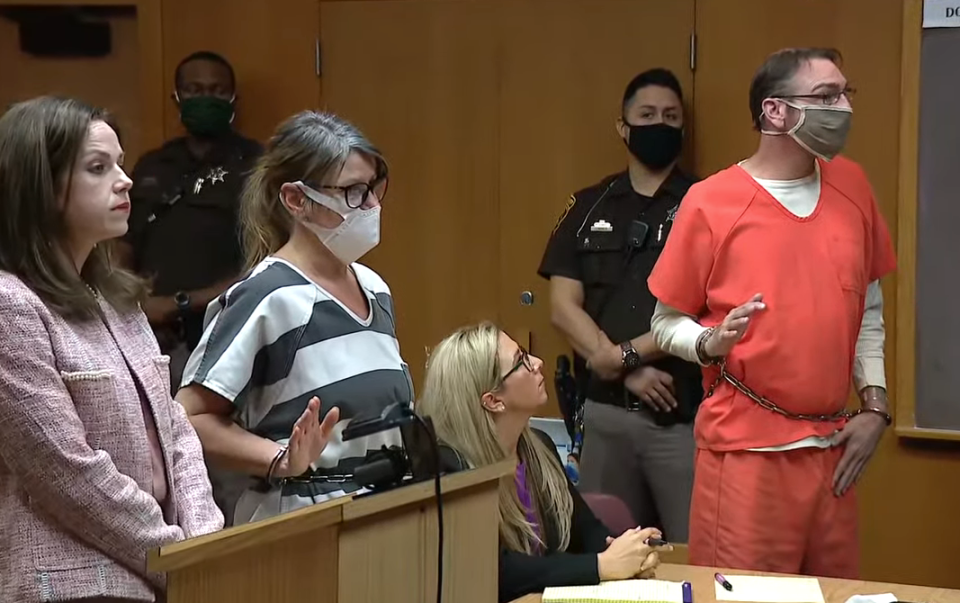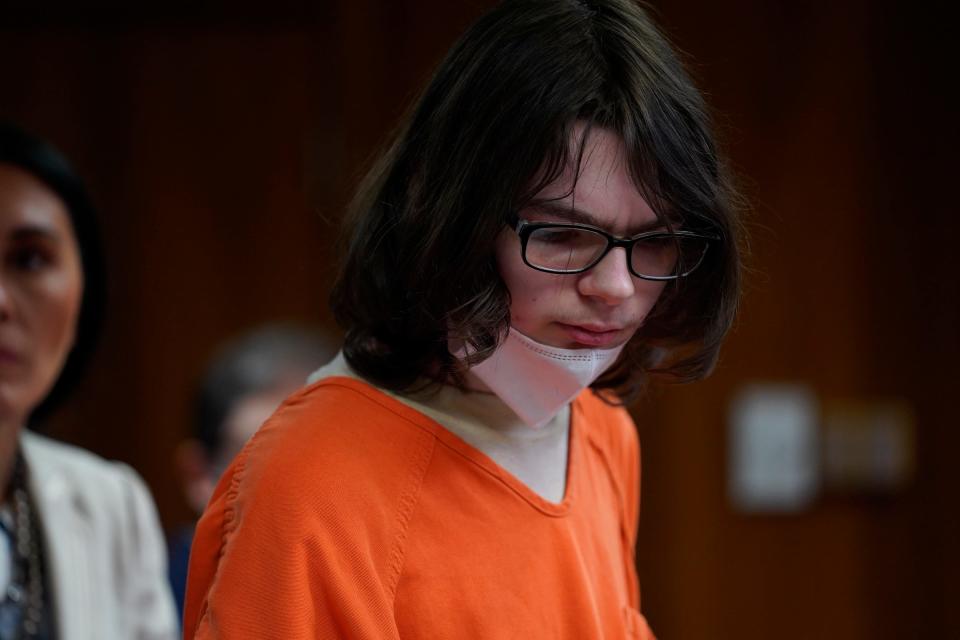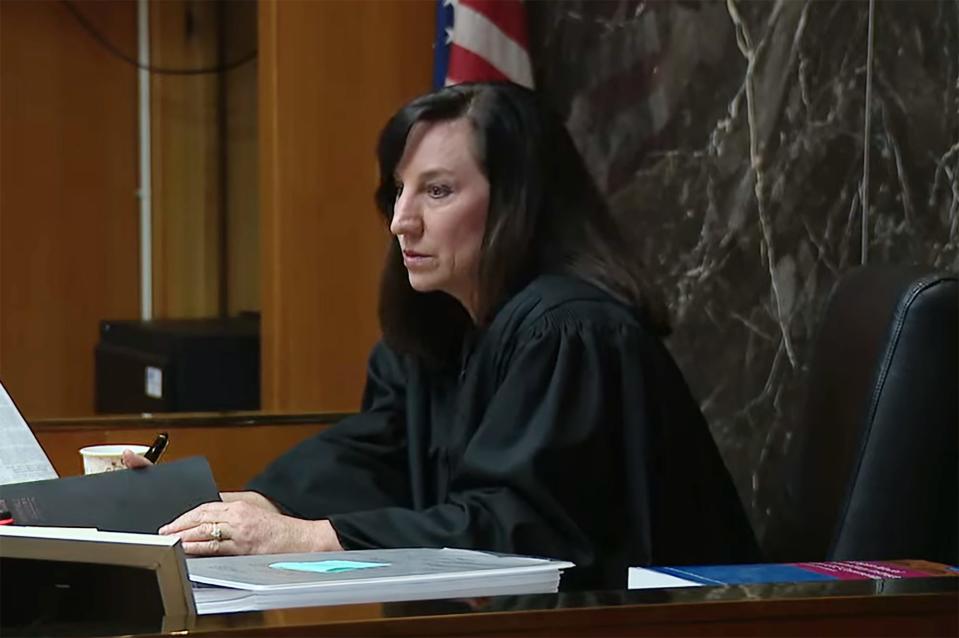Crumbleys' novel case to test theory: Are all school shootings preventable?
James and Jennifer Crumbleys' novel criminal case is on track to test a theory that has never been proven: that all school shootings are preventable.
That's what two mass shooting experts testified at a hearing Friday as prosecutors laid groundwork for their trial strategy that the parents of the Oxford school shooter could have prevented the massacre, but didn't. The experts' theory is that Ethan Crumbley was on a pathway to violence and that somewhere along that pathway, someone could have intervened and stopped him from carrying out his rampage, especially given all the warning signs he was leaking.
Perhaps most notable was the violent drawing Ethan Crumbley had scrawled on his math sheet and was shown to his parents on the morning of the shooting. It included a gun, a bleeding body and the words, "The thoughts won't stop. Help me."

"His note literally says, 'Help me.' ... A common person seeing that math drawing — they would know that it’s cause for intervention," said criminologist Jillian Peterson, whom prosecutors want to use at trial against the Crumbleys, who are charged with involuntary manslaughter over their son killing four students on Nov. 30, 2021. He injured seven others at Oxford High School north of Detroit.
After seeing that drawing, the Crumbleys insisted their son be returned to class — which he was — and never disclosed that they had bought him a gun four days earlier.
The Crumbleys have long maintained that they had no idea their son would carry out a school shooting, that they kept the gun in a locked drawer and did not know he was threatening violence in a journal and notebook he kept — writings the prosecution plans to use against them.
More:Ethan Crumbley: I gave my dad money to buy gun used in school shooting
More:11 months after being shot at school, teen sees Crumbley in shackles
Under the pathway to violence theory, prosecutors say the Crumbleys did two key things that make them accountable:
They ignored multiple warning signs from their son that he was spiraling and planning violence.
They provided him with the opportunity to carry out that violence by buying him a gun.
"Mass shooters have a slow build toward violence over time. They don’t just snap," said Peterson, who noted that while "we can't predict who is going to be a mass shooter," researchers and others can "spot a pattern" and intervene before a plan is carried out.

Specific behaviors are recognized as leading to targeted violence
Peterson, an associate professor of criminology and criminal justice and director of the forensic psychology program at Hamline University in St. Paul, Minnesota, is one of two mass shooting experts who appeared in court Friday as the two sides feuded over whether the experts should be allowed to testify at trial. The other is Dr. Dewey Cornell, a University of Virginia forensic psychologist.
Both experts testified that school shootings can be prevented if people pay attention to a host of warning signs that can appear during any time along a person's pathway to violence. Prosecutors note that the FBI has recognized the “pathway to violence” as a “set of behaviors” leading up to an act of targeted violence, such as a mass shooting. They said the model has been used by law enforcement, universities and researchers.

Oakland County Circuit Judge Cheryl Matthews has to decide whether the experts' testimony is reliable, and whether it could help the jury make a decision as to whether the Crumbleys could have prevented the shooting.
The defense argues that the data around the pathway to violence isn't reliable and that the jury doesn't need experts to explain to them commonsense issues they can conclude for themselves ― such as whether the shooting was preventable or whether the shooter gave signs to his parents or others that he was planning to kill.
But Chief Assistant Prosecutor David Williams urged the judge to let the testimony in, arguing it's crucial to dispel a "pervasive myth" that school shooters just snap and that nothing can be done to stop them. That's how he alleges the Crumbleys responded — that their son's actions came as a total surprise.
"Mass shootings are not inevitable. We are not helpless. They are preventable," Williams said. "Jurors need to hear from experts who have seen this pattern over and over and over again. Judge, this is an emotionally charged case. Four children died."
The defense, meanwhile, has taken issue with the prosecution's assertion that the defendants believe their son snapped.
"We’re not going to argue that he just snapped," defense attorney Shannon Smith told the judge. "The defendants saying they were surprised and caught off guard is not the same as saying he snapped. It's clear Ethan didn't just snap ... the defense would be crazy to suggest he just snapped."
More:Ethan Crumbley pleads guilty to Oxford school shooting: Here's what comes next.
More:Judge in Crumbley parents' case warns prosecutor: Don't taint the jury pool
Lawyers for the Crumbleys asked the judge not to allow the pathway to violence experts to testify at trial, arguing their research is unreliable, untested and includes no examples of school shootings prevented through these methods.
Moreover, Smith said, the experts contend that Ethan Crumbley was provided access to a gun.
"The access to a gun is going to be a highly contested issue at trial," argued Smith, who called the expert testimony "a veiled attempt to get in impermissible testimony."
"All it is signaling to the jury is that these parents are guilty. And that is a conclusion the jury needs to reach by itself, not from an expert," Smith said.
Challenging the data
During Friday's hearing, the defense went back and forth with the experts about their data.
"Are all school shootings preventable?" Smith asked Peterson, the first expert who testified.
"Yes," Peterson replied.
But Smith countered there's no data that shows this, nor is there any "concrete evidence" that shows that if certain things are done, a school shooting will never happen. She said that academia and law enforcement still have "a ways to go on research" in this area.
"I'd say the information we have is pretty good. We just need to get it out there," Peterson responded.
Smith then raised other school shootings, noting red flags about the shooters who nonetheless carried out their crimes. For example, in the recent St. Louis school shooting, the shooter had been committed in a mental health facility prior to the shooting, she noted. And in the 2018 Parkland, Florida, school shooting that left 18 students dead, the shooter was on the FBI's radar before he shot up a high school.
"With him being on the radar, he was still able and did commit a violent school shooting, correct?" Smith asked, as she moved on to another question.
"Have you interviewed anyone who said, 'I knew the shooting was going to happen? I knew he was going to do this before he did it?' " Smith asked.
"I interviewed people who said, 'I was very worried,' " Peterson responded.
Smith then asked Peterson if her database includes any parents who have been charged with involuntary manslaughter for the actions of their child in a school shooting case.
The expert said no. Her research involves only parents who have been charged with buying a minor a gun or violating a safe storage law.
'There were signs, and the jury needs to hear that'
On redirect, a prosecutor asked the expert: "What's different about this case?"
"The sheer volume of leakage," the expert testified, referring to the warnings from Ethan Crumbley that he was planning to do harm.
Also noteworthy, Peterson said, was that the parents were called to the school about the warning signs and knew he had access to a gun.
In closing arguments, the defense urged the judge to block the experts' testimony, while the prosecutor pleaded with her to let it in.
"Every time there’s another shooting … there’s always someone who says there were no signs," Williams said. "And every time it turns out to be wrong. There were signs, and the jury needs to hear that … so that they can determine if these defendants could have prevented the shooting.”
Judge Matthews said she would issue a written opinion.
The hearing came four days after the Crumbleys' son, Ethan Crumbley, 16, pleaded guilty to all 24 counts with which he was charged, including first-degree murder and terrorism. He admitted he murdered four classmates, injured others and hoped to cause panic and fear in his school. He faces up to life in prison without parole when he is sentenced in February.
Contact Tresa Baldas: tbaldas@freepress.com
This article originally appeared on Detroit Free Press: Crumbleys' case tests key question: Are school shootings preventable?

